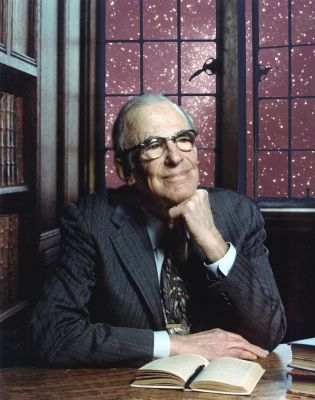
In the case of the Hubble Space Telescope, arguably the most successful and celebrated scientific instrument ever built, it took fifty years from conception to full realization. The most important champion of the project was Lyman Spitzer.
Spitzer (1914–1997) studied astronomy at Yale, Cambridge, and Princeton University. During World War II, he worked on the development of sonar. In 1947 he succeeded Henry Norris Russell as Chair of Princeton’s Astrophysical Sciences Department. During a long and productive career, Lyman Spitzer shaped three major fields of astrophysics—interstellar matter, plasmas, and the dynamics of star clusters. His work on interstellar matter began when he noticed that elliptical galaxies have only old stars and no nebulas of gas and dust, while spiral galaxies include young stars and nebulas. He realized that stars must now be forming in spirals from the gas and dust of the nebulas. Spitzer went on to establish the field of interstellar matter as a major branch of astrophysics.
But his greatest legacy is the Space Telescope. The idea of putting a telescope in orbit, above the obscuring veil of the Earth’s atmosphere, had been suggested as far back as 1923 by the German rocket pioneer Hermann Oberth. But rockets in those days were feeble and uncontrollable devices. Then, during World War II, the Germans developed the V-2 weapon, a powerful ballistic rocket which left the atmosphere in order to come down on a distant target. It opened the way for the rocket-powered transport of payloads into space (including instruments and telescopes instead of bombs). Spitzer recalled in a discussion about the Space Telescope that the V-2 rockets “made it all seem possible.”
In 1946, Spitzer wrote a report for the RAND Corporation on “Astronomical Advantages of an Extra-Terrestrial Observatory,” in which he explored the advantages of a space-based telescope of five to fifteen meters in diameter. At the time of this astonishing proposal, the Palomar 5-meter telescope, then the largest in the world, was still under construction. And it was on an accessible mountaintop, not in orbital space. In his report, Spitzer said that the best reason to build a space-based telescope would be to “uncover new phenomena not yet imagined, and perhaps to modify profoundly our basic concepts of space and time.”
The Space Telescope was finally launched in April 1990, after a long delay following the explosion of the Space Shuttle Challenger in 1986. But when the first images were transmitted to the ground, there was a terrible disappointment. The images were blurred and showed the telltale signs of a failure in optical design. The 2.4–meter primary mirror had been crafted with exquisite accuracy but to the wrong shape! Fortunately the telescope had been designed for service visits by astronauts, and Spitzer contributed a level of optimism after this apparent disaster. He said calmly, “These things take time. We’ll just have to fix it.” The next Shuttle trip to visit the telescope carried a set of corrective optics which, when installed, allowed the Space Telescope to fully realize its goals.
Since then, the Hubble Space Telescope, named in honor of Edwin Hubble, discoverer of the extragalactic universe, has made impressive discoveries in many branches of astronomy. It has contributed to our understanding of the large-scale structure of the universe, and of stellar evolution and the dynamics of galaxies.It has produced firm evidence for black holes, and provided images of objects and phenomena not even imagined in the 1940s. Lyman Spitzer was right when he predicted that the Space Telescope would profoundly affect our conception of the universe. A gentle and graceful man, loved by all who knew him, Spitzer lived to see the marvelous images produced by the fully operational Space Telescope that was his brainchild.
Credit : American Museum of Natural History
Picture Credit : Google
Leave a Reply